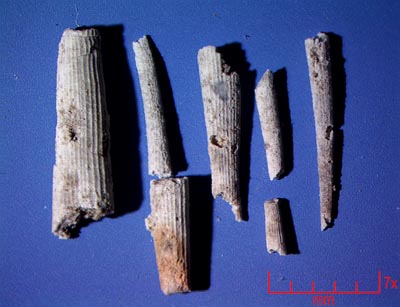|
A minor but
very important faunal element in the upper early Permian Fort
Apache Limestone are Scaphopods - Or more commonly known today
as "Tusk Shells". These mollusks were conical tubes
- some linearly ribbed some smooth, with both ends open for water
current movement. Fortunately for us, In 1963 White, in his
monumental GSA Memoir 89 had found the smooth scaphopods, and
identified them as Plagioglypta. We also found a smaller number
of ribbed scaphopods which were a different genus. The most complete
scaphopod material never had transverse ribs, even in their juvenile
sections.
Preservation
A wide range of
sizes of scaphopods were found, ranging from millimeter sized
diameters to nearly a centimeter. The larger conchs were usually
flattened and many cracked under the pressure of the overlying
sediments. About half of them were still filled with terriginous
material after dissolution in acid, and only the short sections
were free of internal sediment. Most were seen to have a curved
profile, especially the juveniles.
Smooth
exterior (Plagioglypta canna)
 |
Four
sections of Plagioglypta, with varying degrees of flattening.
(7x) A complete specimen would have been up to 80mm long. |
 |
Although
poorly preserved in white silica, this pair of nearly complete
tiny scaphopods shows the curving nature very well. |
 |
Three
more with varying amounts of curvature. |
 |
One
of the largest flattened specimens. |
 |
Section
of a large scaphopod. |
 |
End
on view showing wall thickness. The top is cracked inward from
the overlying sediment pressure. |
Linearly
ribbed exterior (Dentalium sp.)
 |
The
ornamented exterior of this genus is stunning under the side
lighting! |
 |
Worn
piece with the larger part at bottom having its ribs worn smooth
by wave action. |
 |
Close
up of linear ribbing. |
|

